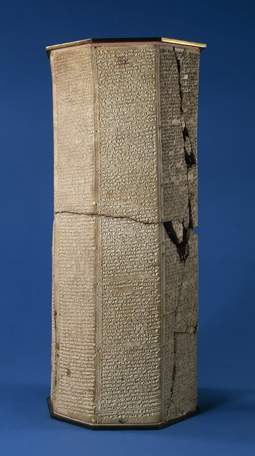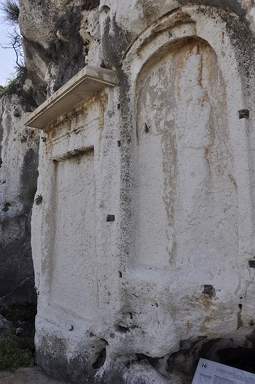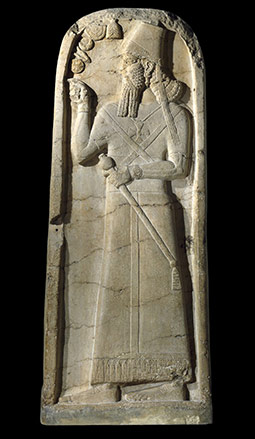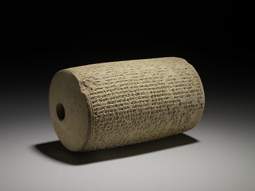Royal inscriptions
Royal inscriptions were the most direct and visible means by which Assyrian kings recorded and disseminated their achievements. They acted as official records of a king's reign and provided important means of demonstrating his compliance with the demands of Assyrian royal ideology.
Tradition and innovation at the Assyrian court

Image 1: Clay prism of king Tiglath-pileser I PGP listing the achievements of his reign. The prism is a fine example of a foundation deposit, hidden away in the foundations or walls of important buildings. BM 91033. View large image on British Museum website. © The Trustees of the British Museum.
Royal inscriptions enjoyed a long tradition in Mesopotamia, where the earliest texts of this kind can be traced back to the 3rd millennium BC. Assyrian kings adapted the genre and made certain innovations which came to characterise Neo-Assyrian TT royal inscriptions. Perhaps the most important of these innovations was Tiglath-pileser I's development of what we now call "annals". These were autobiographical accounts of the king's military campaigns, narrated in chronological order and eventually dated by regnal year. By contrast, "summary inscriptions" grouped the events of a king's reign by theme, such as geographical location.
Royal inscriptions took a variety of forms. Among the most visually impressive were stelae TT and bas-reliefs TT carved from stone and displayed in palaces, temples or public spaces. Such monumental objects were also set up in symbolically significant locations in Assyria and beyond (Image 2). The large image of the king which invariably accompanied the inscription served as a sort of substitute presence of the king, and marked the far-away location as part of the Assyrian "officially existing world". The imagery also served to convey a powerful visual message which could be appreciated by both literate and illiterate audiences.
Inscriptions of Assyrian kings have played a central role in the study of Assyria and its history since cuneiform TT texts were first excavated and began to be deciphered in the 19th century. In fact, in 1857 the Royal Asiatic Society TT used a clay prism of king Tiglath-pileser I PGP (Image 1) as a test case which confirmed the successful decipherment of the cuneiform script.
The king as warrior-hero

Image 2: Many generations of Near Eastern rulers celebrated their attainment of the Mediterranean coast by carving reliefs TT into the rock of Mount Lebanon PGP at the mouth of the Nahr el-Kalb river PGP . Here, a relief of the Assyrian king Esarhaddon PGP is visible to the right of a relief of Egyptian king Ramesses II PGP (online translation: RINAP 4: 103). Photo from Livius.org. View large image on the Livius.org website.
In Assyrian official texts, the king presented himself above all as a warrior and a hero. In this, kings moulded themselves on the divine hero Ninurta, whose worship played an important role in Neo-Assyrian religion. For instance, Assurnasirpal II dedicated a temple to Ninurta next to the ziggurat of his new capital city, Kalhu. War was seen as a form of divine ordeal, and victory a sign of divine favour. Kings therefore sought to emulate Ninurta's achievements and celebrated their military victories as fulfilment of their duty to defend and enlarge the Assyrian territory, and a confirmation of their right to rule. From a practical perspective, military conquest of course played a critical role in establishing and maintaining control over the Assyrian empire. Together with the ideological emphasis on war, this certainly helps account for the brutality which sometimes permeates royal texts, and which has given the Assyrians a largely undeserved reputation as an unusually cruel and bloodthirsty people.
By contrast, the most visible role of Babylonian kings in their royal inscriptions was that of a pious builder. As a result, Assyrian kings who also ruled Babylonia PGP under a dual monarchy - first established by Tiglath-pileser III PGP - adopted a different style of self-presentation as Babylonian kings. A portrayal of king Assurbanipal PGP as a builder in the Babylonian tradition can be seen in Image 3. We should bear in mind, however, that the official image of the king did not necessarily reflect the underlying historical reality of kingship in these two countries, where peaceful activities as well as military intervention formed an integral part of a king's duties.
Who wrote them?
The authors of royal inscriptions have tended to remain anonymous in order to maintain the fiction of the king's own voice. We do know, however, that some texts at least were composed by the king's "chief scribe". For instance, the account of Sargon II PGP 's eighth annual campaign, known as the Letter to Aššur, is quite openly attributed to the king's chief scribe TT , Nabu-šallimšunu PGP . Holders of this prestigious and powerful office frequently acted as the king's personal scholar TT (ummânu) and advisor, and were therefore well versed in the best means to shape their royal masters' self-presentation in ways which served their ideological needs.
Correspondence from the reigns of kings Esarhaddon and Assurbanipal makes it clear that royal inscriptions were subject to the king's approval, as demonstrated by a letter to Assurbanipal which informs the king:
We shall write the name of the king, my lord, on the foundation stone which we laid in the foundations of the city walls of Tarbiṣu PGP . Let the king, my lord, write me what we should write (on it) and we shall write accordingly. (SAA 16: 143)
In addition, since we know that a high level of scribal education is attested for Assurbanipal and may have been enjoyed by others, it is not unlikely that Assyrian kings worked with their advisors to formulate their own message.
Writers of royal inscriptions had access to a variety of materials on which they could draw in composing their texts. These ranged from contemporary reports, including lists of booty and itineraries of military campaigns, to chronicles (such as the eponym chronicles) and letters. As a king's reign progressed, his official accounts could be re-edited, abridged or expanded as necessary to suit changing circumstances or simply to make room for recent achievements. Embarrassing events could be expunged from the official record to preserve the king's reputation. Shortly after his accession, Sennacherib appointed as Babylonian king one Bel-ibni PGP , "who had grown up like a puppy in my palace" (RINAP 3 Sennacherib 3: 13). However, in 700 BC Bel-ibni rebelled against his master and was promptly removed from the Babylonian throne. Accordingly, inscriptions composed after this date make no mention of Bel-ibni. Fortunately earlier versions remained unchanged and allow us to reconstruct the episode.

Image 3: Stone stela of king Šamši-Adad V PGP from Nabu's temple in Kalhu. BM 118892. View large image on British Museum website. © The Trustees of the British Museum.
... and who read them?
The intended audience was dependent on the type of inscription. The gods, of course, were able to see everything, whether out in the open or hidden away, and so formed a primary audience for all royal texts. The identity of the compositions' human audience was linked to their location. Reliefs in palaces or temples were accessible to those who lived or worked in them, or were lucky enough to receive an invitation. Monumental inscriptions displayed in public places had a wide and varied audience, while those in distant, isolated locations, such as the Tigris Grotto PGP which marked the source of the Tigris river, might rarely be seen by anyone at all.
Only a small proportion of the Assyrian population was able to read and so understand the detailed content of royal messages. However, even an illiterate person could appreciate the visual elements of monumental texts (Image 4) and their significance as symbols of the Assyrian king's unrivalled might.
A handful of royal inscriptions took the unusual form of a letter addressed to the god Aššur and other Assyrian deities. The only complete example of these "Letters to the god" (or "Letters to Aššur") comes from the reign of Sargon II PGP (r. 721-705 BC), and narrates the details of his successful military campaign undertaken in the Zagros Mountains PGP during his eighth regnal year (714 BC). The text opens with the following address:
May (all) be extremely well with Aššur, father of the gods, great lord who dwells in Ehursaggalkurkurra, his great temple! May (all) be extremely well with the gods of destinies (and) the goddesses who dwell in Ehursaggalkurkurra, their great temple! ... May (all) be extremely well with the city and its people, to the palace (and) the dweller therein! (All) is extremely well with Sargon, the sacrosanct priest, the servant who reveres your great divinity, and with his army. (1)
It has been suggested that the "Letters to the god" were performed before the citizens of Assur as part of the traditional oral report given by the king or one of his representatives to the city and its priesthood. The narrative is more lively and entertaining than that of more standard royal inscriptions, inserting humour, drama, direct speeches and details of foreign lands designed to hold an audience's interest. The composition concludes with a long list of booty captured during the campaign, which may have been put on display to add an important visual element to the performance.
Royal time capsules
Not all royal inscriptions were intended to be displayed in the open. Some were deliberately hidden away in the foundations or walls of newly-built or reconstructed buildings. These "foundation documents" (or foundation deposits TT ) could take many different forms, from objects or figurines TT bearing short inscriptions to tablets TT made of clay or precious metals, or much longer texts written out on clay cylinders or prisms (Image 1). In addition to commemorating the construction works, foundation documents served as durable records of the achievements of the kings who commissioned them. Their hidden location limited the intended audience to the gods – who as divine beings were able to see all that is concealed – and future rulers, who would come across these ancient time capsules in the course of their own rebuilding works. The inscriptions anticipated this process:
May a future ruler read aloud t[his] inscription, wash (it) with water, anoint (it) with oil, (and) make an offering. (Then) those gods will hear his prayers! (RINAP 1 Tiglath-pileser III 35:iii 6'-10')
The process of uncovering the buried inscriptions of previous kings was thus a kind of early archaeology. Through it, Mesopotamian kings maintained a tangible connection to the historical past and - though their own inscriptions - to the future. The Cyrus Cylinder, undoubtedly the most famous foundation deposit in the Babylonian tradition, provides an example of this. Following the Persian king's conquest of Babylon, it records his rebuilding of the city and his discovery of an inscription of Assurbanipal, the last great king of Assyria:
[I completed] the quay of baked brick on the bank of the moat which an earlier king had bu[ilt but not com]pleted its work... I built anew, and [completed] its [work]... I saw within it an inscription of Assurbanipal, a king who preceded me... (Translation taken from the British Museum website)
Royal inscriptions as literature
The elevated nature of royal inscriptions was emphasised by the formal language used to compose them. While everyday documents such as letters and legal contracts were written using the commonly spoken Assyrian dialect of the of Akkadian TT language, royal inscriptions employed an archaising form known as Standard Babylonian. This was a purely literary dialect which was used to write much of the literature passed down in the scribal tradition of the 1st millennium.
While historical royal narratives may at first glance have little in common with literary compositions, the scribes who composed them borrowed - consciously and unconsciously - from material with which they were familiar. Inscriptions of earlier kings were an obvious influence, but scribes also incorporated references to scholarly texts and even literary works such as the Epic of Gilgameš or the Babylonian Epic of Creation. The result is a form of writing which combines tradition with innovation. Assyrian royal inscriptions represent a complex blend of history, ideology, mythology and scholarship which cannot easily be classified but which continues to provide a fascinating window into ancient Assyria.
Content last modified: 18 Dec 2019
References
- Thureau-Dangin, F., 1912. Une relation de la huitième campagne de Sargon (714 av. J.-C.) (Textes cunéiformes du Louvre 3), Paris: Geuthner (free online edition at The Internet Archive), pp. 3, ll.1-5. (Find in text ^)
Further reading
- Grayson, A.K. and J. Novotny, 2012. The Royal Inscriptions of Sennacherib, King of Assyria (704-681 BC), Part 1 (Royal Inscriptions of the Neo-Assyrian Period. Volume 3/1), Winona Lake: Eisenbrauns.
- Grayson, A.K. and J. Novotny, 2014. The Royal Inscriptions of Sennacherib, King of Assyria (704-681 BC), Part 2 (Royal Inscriptions of the Neo-Assyrian Period. Volume 3/2), Winona Lake: Eisenbrauns.
- Leichty, E., 2011. The Royal Inscriptions of Esarhaddon, King of Assyria (680-669 BC) (Royal Inscriptions of the Neo-Assyrian Period. Volume 4), Winona Lake: Eisenbrauns.
- Luukko, M., 2007. "The administrative roles of the 'Chief Scribe' and the 'Palace Scribe' in the Neo-Assyrian period", State Archives of Assyria Bulletin 16, pp. 227-256 (free PDF from Assyrian Empire Builders, 252 KB).
- Oppenheim, A.L., 1960. "The City of Assur in 714 B.C.", Journal of Near Eastern Studies 19, pp. 133-147 (PDF available via JSTOR for subscribers).
- Shafer, A., 2007. "Assyrian Royal Monuments on the Periphery: Ritual and the Making of Imperial Space", in M.H. Feldman and J. Cheng (eds.), Ancient Near Eastern Art in Context: Studies in Honor of Irene J. Winter, Leiden: Brill, pp. 133-159.
- Tadmor, H., 1997. "Propaganda, Literature, Historiography: Cracking the Code of the Assyrian Royal Inscriptions", in S. Parpola and R.M. Whiting (eds.), Assyria 1995: Proceedings of the 10th Anniversary Symposium of the Neo-Assyrian Text Corpus Project, Helsinki, September 7-11, 1995, Helsinki: The Neo-Assyrian Text Corpus Project, pp. 325-338.
- Tadmor, H. and S. Yamada, 2011. The Royal Inscriptions of Tiglath-pileser III (744-727 BC) and Shalmaneser V (726-722 BC), Kings of Assyria (Royal Inscriptions of the Neo-Assyrian Period. Volume 1), Winona Lake: Eisenbrauns.
Silvie Zamazalová
Silvie Zamazalová, 'Royal inscriptions', Nimrud: Materialities of Assyrian Knowledge Production, The Nimrud Project at Oracc.org, 2019 [http://oracc.museum.upenn.edu/nimrud/ancientkalhu/thewritings/royalinscriptions/]
